Fisheries Timeline
Chronology of tribal fishing and fishing rights on the Columbia River
| Time Immemorial | Indian people have lived in the Columbia River Basin for thousands of years. Salmon was their staple of life and the foundation of their culture and economy. It was also an important part of their religion. According to conservative estimates, prior to European settlement, the Columbia River’s annual salmon returns ranged from 11-16 million fish. |
| 1855 | Treaties with Columbia River tribes were signed. In these treaties, tribes ceded most of their lands – but reserved the right to fish at “all usual and accustomed fishing places…in common with citizens.” |
| 1905 | In the first major fishing rights case to reach the Supreme Court, U.S. v. Winans, the justices held that treaty Indians had reserved the right to cross non-Indian lands to fish at “usual and accustomed” places and that treaties were to be interpreted the way Indians had understood them. |
| 1938 | Congress passed the Bonneville Project Act to market power from federal dams on the Columbia. Dams would eventually inundate important Indian fishing places and impede salmon migration to 2,800 miles of fish habitat.Congress passed the Mitchell Act, which promised that fish lost because of the dams would be replenished with the help of hatcheries. |
| 1942 | The Supreme Court decided in Tulee v. Washington that because a treaty takes precedence over state law, Indians with tribal treaty rights could not be required to buy state fishing licenses. However, the court also ruled that the state could regulate treaty fisheries for purposes of conservation. |
| 1945 | Congress set aside lands as mitigation for inundating Indian villages behind Bonneville Dam. (By the 1960s, five in-lieu sites had been set aside: Cooks, Wind River, Underwood, Lone Pine, and Cascade Locks.) |
| 1948 | State and federal fish agencies began implementing the Mitchell Act, siting only two of the 25 hatcheries in the tribes’ upriver fishing areas. |
| 1957 | Celilo Falls was inundated behind the newly completed The Dalles Dam.The Columbia River Compact restricted commercial fishing between Bonneville and Miller Island and prohibited all commercial salmon fishing (treaty Indian & non-Indian) above Miller Island. |
| 1960 | The U.S. and Canada signed the Columbia River Treaty. The treaty required Canada to build three massive water storage dams and allowed the U.S. to build Libby Dam. The treaty dealt solely with flood control and hydropower generation. The tribes were not consulted and tribal fishing interests were not addressed in the treaty. |
| 1968 | Fourteen Yakama tribal members filed suit against Oregon’s regulation of off-reservation fishing (Sohappy v. Smith). The U.S. and the Yakama, Warm Springs, Umatilla, and Nez Perce tribes also sued to enforce Indian off-reservation fishing rights (U.S. v. Oregon). The federal court combined the two cases. |
| 1969 | Judge Belloni, in Sohappy v. Smith/U.S. v. Oregon (Belloni decision), ruled that the four treaty tribes were entitled to a “fair share” of the fish runs and the state was limited in its power to regulate treaty Indian fisheries. The state could only regulate when “reasonable and necessary for conservation.” Further, state conservation regulations could not discriminate against the tribes, using the least restrictive means necessary. |
| 1974 | In U.S. v. Washington (Boldt Decision), Judge Boldt mandated that a “fair share,” meant 50 percent of the harvestable fish destined to pass the tribes’ usual and accustomed fishing places and reaffirmed tribal management powers. Belloni then applied the 50/50 principle to Columbia River fisheries.In Settler v. Lameer, the Ninth Circuit Court of Appeals ruled that the treaty fishing right was a tribal right, not an individual right, and that tribes had reserved the authority to regulate tribal fishing on and off the reservations. |
| 1975 | The U.S. Army Corps of Engineers completed Lower Granite Dam, the last of four lower Snake River dams, compounding downstream passage problems and causing further declines in fish runs. The total number of dams on the mainstem Columbia and Snake rivers rose to 18. |
| Feb 1977 | The federal court, under its jurisdiction in U.S. v. Oregon, approved a five-year plan that set up an in-river harvest-sharing formula between non-Indian and Indian fisheries. The plan failed because it did not include specific controls on ocean harvests or specific measures to replace fish runs destroyed by development. |
| Mar 1977 | Yakama, Warm Springs, Umatilla, and Nez Perce tribes created, by resolution, the Columbia River Inter-Tribal Fish Commission. |
| 1979 | The Supreme Court upheld U.S. v. Washington (Boldt Decision).Columbia River, Puget Sound, and Washington coastal tribes sued the Secretary of Commerce over ocean fishing regulations because a large percentage of treaty fish were being caught in waters managed by the Department of Commerce. Columbia River tribes also sued in 1980, 1981, and 1982 (Confederated Tribes, et al. v. Kreps; Yakama, et al. v. Klutznik; Hoh v. Baldrige; and Yakama, et al. v. Baldrige). As a result, the federal government was held to have a legal obligation to regulate the ocean fishery to ensure that a reasonable number of salmon reached tribal fishing places on the Columbia River. |
| 1980 | Congress passed the Northwest Power Act, which, for the first time, mandated that Columbia River power production and fisheries be managed as coequals. It called for a Fish and Wildlife program to make up for losses caused by federal water development in the Basin.The Federal District Court issued the U.S. v. Washington (Phase II) decision that included hatchery-produced fish in the 50/50 allocation and affirmed a right to protection of the habitat supporting fish runs subject to treaty catch. |
| 1982 | The Northwest Power and Conservation Council – the body charged with implementing the Power Act – adopted a Fish and Wildlife program that drew heavily from tribal recommendations. |
| Aug 1982 | The Columbia River Inter-Tribal Fisheries Enforcement department was established and charged with enforcing tribal fishing regulations along the Columbia River Zone 6. |
| 1985 | President Ronald Reagan and Canadian Prime Minister Brian Mulroney signed the U.S./Canada Pacific Salmon Treaty, which reduced Canadian and Alaskan harvest of Columbia River salmon and added tribal representation to the international decision-making body along with other government fish managers. |
| 1986 | Coho salmon in the Snake River went extinct. |
| 1988 | Congress directed the Corps of Engineers to acquire and develop at least six sites on the Bonneville pool and to improve 20 specified locations for treaty fishing access sites between Bonneville and McNary dams. (By 2010, this legislation had created 24 sites with two more under development.)After five years of negotiations, the states of Oregon and Washington, federal fishery agencies, and the treaty tribes agreed to the Columbia River Fish Management Plan, a new, detailed harvest and fish production process under the authority of U.S. v. Oregon. Judge Marsh entered the plan as an order of the U.S. District Court. |
| 1991 | Several salmon runs from the Snake River, the Columbia’s largest tributary were listed under the Endangered Species Act. |
| 1994 | In Idaho Department of Fish and Game (IDFG) v. National Marine Fisheries Service (NMFS), brought under the ESA, Judge Marsh ruled that NMFS’ biological opinion of “no jeopardy” regarding hydrosystem operations on the Columbia and Snake violated the act. He ordered the fish management parties to recommend to NMFS what hydrosystem changes were needed to restore endangered salmon.U.S. v. Oregon fall season litigation pitted tribal treaty rights against the Endangered Species Act. The conflict had the potential to shut down the tribal Zone 6 fishery. The dispute was settled out of court. The Snake River fall Chinook supplementation program was a direct result of this litigation. |
| 1995 | The four CRITFC member tribes developed their own Columbia River salmon restoration plan, Wy-Kan-Ush-Mi Wa-Kish-Wit (Spirit of the Salmon). The plan’s goal is to have 4 million salmon returning to the Columbia River by 2020. |
| 1997 | Upper Columbia native steelhead were declared endangered under the Endangered Species Act. (Upper Columbia spring chinook are declared endangered in 1999.) |
| 1998 | Human development in the Columbia River Basin reduced the area available to salmon and steelhead to just 73,000 square miles. Of all salmon and steelhead habitat in the Basin, 55% of the area and 31% of the stream miles have been eliminated by dam construction. |
| 1999 | Lower Columbia chum salmon, lower Columbia fall chinook salmon, Willamette and Clackamas spring chinook salmon, Willamette winter steelhead, and middle Columbia winter and summer steelhead were declared threatened under the Endangered Species Act. |
| 2004 | The Technical Review Team for the lower Columbia and Willamette rivers published a status report for salmonids, finding that all spring Chinook and winter steelhead populations were either at ’high’ or ‘very high’ risk of extinction and that there were no viable wild populations. |
| 2008 |
Three significant agreements were signed:
1 The Nez Perce Tribe declined to be a party to the Columbia Basin Fish Accords but approved CRITFC participation. Tribal salmon gross sales reached $4 million. As comparison, the 2005 gross sales totaled $700,000. |
| 2010 | Columbia River Inter-Tribal Fisheries Enforcement received law enforcement commissions from each of the four member tribes and the Bureau of Indian Affairs. To commemorate the occasion, a special intertribal oath emphasizing tribal sovereignty and service to the tribes was administered to all officers. |
Spearing Fish

Early 1900’s photo by Edward C. Curtis
Salmon Culture
“We people of the Yakama, Warm Springs, Nez Perce, and Umatilla tribes flourished here in the Columbia River Basin for thousands of years. Our religion, culture, and livelihood depended upon the return of the salmon. With the westward expansion of the United States, our fish began to diminish. Despite this, we have never given up. We continue to work and pray for their abundant return.”
